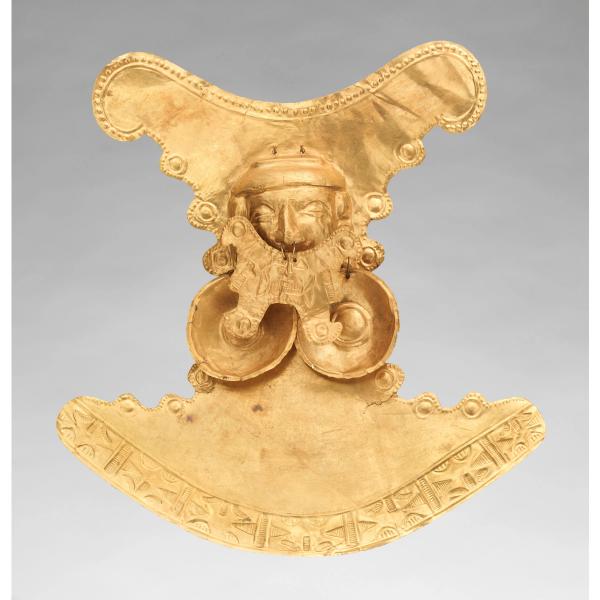Pectoral with face
The pectoral was formed by hammering and cutting gold sheet, adding further embellishment by working the sheet from behind (repoussé) to create delicate patterning along the edges of the ornament. The face itself was likely made with the use of a form made of wood or a similar material to create the serene, inexpressive face that is found on many works of this period. This stylized face is also found on headdress ornaments (see accession number 66.196.24) and tweezer-like arm ornaments (see accession number 1974.271.51).
This pectoral was once part of an ensemble that would have included a headdress, ornaments for the nose, ears, arms, and sometimes legs, along with regalia such as a staff, spear-thrower, flask, and lime dipper (see, for example, accession number 1991.419.23). Enveloped in gold, a material closely associated with the generative power of the sun, Calima elites in full regalia would have been a spectacular sight in performance, radiant figures of sacred power.
References and Further Reading
Botero, Clara Isabel, Roberto Lleras Pérez, Santiago Londoño Vélez and Efraín Sánchez Cabra. The Art of Gold, The Legacy of Pre-Hispanic Colombia: Collection of the Gold Museum of Bogotá. Mexico, D.F.: Fondo de Cultura Económica, Banco de la República, 2007.
Jones, Julie, ed. The Art of Precolumbian Gold: The Jan Mitchell Collection. New York: Metropolitan Museum of Art, 1985.
Pérez de Barradas, José. Orfebrería Prehispánica de Colombia Estilo Calima. Bogotá, Colombia: Banco de la República, 1954.
Morand, Marie Claude. Calima: Colombie précolombienne. Martigny, Switzerland: Foundation Pierre Gianadda, 1992.
Schrimpff, Marianne Cardale, ed. Calima and Malagana: Art and Archaeology in Southwestern Colombia. Bogotá, Colombia: Pro Calima Foundation, 2005.
Uribe Villegas, María Alicia and Marcos Martinón-Torres, "Metallurgy and Prestige in Ancient Colombia: Yotoco and Malagana Adornment and Muisca Offerings," in Joanne Pillsbury, Timothy Potts, and Kim N. Richter, Golden Kingdoms: Luxury Arts in the Ancient Americas, pp. 44-53. Los Angeles: Getty Publications, 2017.
Artwork Details
- Title: Pectoral with face
- Artist: Calima (Yotoco) artist
- Date: 100 BCE–800 CE
- Geography: Colombia
- Culture: Calima (Yotoco)
- Medium: Gold (hammered)
- Dimensions: H.12 3/8 x W. 11 5/8 x D. 1 3/8 in. (31.4 x 29.5 x 3.5 cm)
- Classification: Metal-Ornaments
- Credit Line: The Michael C. Rockefeller Memorial Collection, Bequest of Nelson A. Rockefeller, 1979
- Object Number: 1979.206.506
- Curatorial Department: The Michael C. Rockefeller Wing
Audio

1638. Gold ornaments, Calima (Yotoco) artists
Joanne Pillsbury
JOANNE PILLSBURY: In ancient Colombia, gold was very closely associated with the sun. So, an individual who had the privilege to wear this extraordinary regalia would have been associating themselves with this generative power of the sun.
JOSÉ MARÍA YAZPIK (NARRATOR): Joanne Pillsbury, curator of Ancient American Art, Metropolitan Museum, describes how these adornments would have been worn in some of the most important ceremonies of their time.
JOANNE PILLSBURY: The central object, this sort of I-shaped object, is a pectoral. You can see two holes that would have allowed this object to be suspended by a cotton cord from the neck, and the pectoral has, as one of the primary images, this very serene face.
You’ll notice the same sort of face on the headdress frontal, the ornament at the very top of the case, and we even see it on one of the tweezer-like arm bands to the lower right. So, almost the entire body would have been covered with these gold ornaments.
JOSÉ MARÍA YAZPIK: On the pectoral, the central face is adorned with a smaller, H-shaped ornament dangling from two gold wires.
JOANNE PILLSBURY: The little nose ornament itself also bears a face. If you look closely, you can see triangular eyes and a mouth with teeth bared. So, there’s this wonderful interplay of revealing and concealing a body. These ornaments are about extending the self. They’re about radiance both in terms of the material but also in expanding the image of the wearer.
It would have been a spectacular scene to see this golden person wearing this regalia. It would have reflected the sun, being an element of the sun itself. It would have caught the light by flickering firelight even. So, it would have been an extraordinary vision to all who had the privilege to observe this.
More Artwork
Research Resources
The Met provides unparalleled resources for research and welcomes an international community of students and scholars. The Met's Open Access API is where creators and researchers can connect to the The Met collection. Open Access data and public domain images are available for unrestricted commercial and noncommercial use without permission or fee.
To request images under copyright and other restrictions, please use this Image Request form.
Feedback
We continue to research and examine historical and cultural context for objects in The Met collection. If you have comments or questions about this object record, please complete and submit this form. The Museum looks forward to receiving your comments.